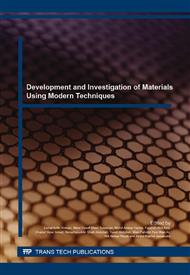p.220
p.225
p.231
p.236
p.240
p.247
p.252
p.257
p.262
Optimization and Characterization of Anatase Formed on Anodized Titanium in Phosphoric Acid
Abstract:
Titanium (Ti) is widely used in dental and orthopedic implants because of its good biocombatibility and high corrosion resistance. Titanium oxide (TiO2) has shown to exhibit strong physicochemical bonding between Ti implant and living bone because of its ability to induce bone-like apatite in a body environment. Ti is always coated by an oxide surface layer of 1.5-10 nm thickness. TiO2 crystalline structures; anatase and rutile present several distinctive features, such as photocatalytic behaviour, superhydrophilicity and biocompatible properties. Anodic oxidation is used to modify the surface of pure titanium in a phosphuric acid electrolyte in order to maximize and characterize the TiO2 anatase crystalline phase. In the present work, thick films of the anatase polymorph of TiO2 were formed on commercially pure Ti foil under potentials 200 V-350 V at current densities 40 and 60 mA/cm2 for 10 min. Multiple characterization techniques were used. Glancing angle X-ray diffraction (GAXRD) is used to obtain crystalline phases, field emission scanning electron microscope (FESEM) is used to obtain surface images and water contact angle (WCA) is used to obtain the wettability of the oxide surface. According to GAXRD results the intensity of the major peak increased with increasing applied voltage and current density while decrease with molar concentration. This means that the amount and/or crystallinity of anatase are/is influenced with these parameters. The coated oxides obtained small amount of anatase is comparing to films anodized in H2SO4 electrolyte. Which confirm that slower crystallization in H3PO4 than in H2SO4. FESEM images obtained that as the voltage increased, the film breaks down locally and results in a porous surface. The porosity and the pore size increase with the increasing voltage. The pore size diameter at 300V for 0.3 M can reach up to 1μm. As for WCA results the coated samples at higher voltages (250 V, 300 V and 350 V) and molar concentration 0.3 M have shown more hydrophilic surface, with sample anodized at 350 V at 0.3 M have the lowest contact angle, thus the highest surface energy. While samples anodized at 200 V voltage observed more hydrophobic surface with sample anodized at 200 V at 0.1 M have the lower wettability, thus the lowest surface energy.
Info:
Periodical:
Pages:
240-244
Citation:
Online since:
January 2016
Authors:
Keywords:
Price:
Сopyright:
© 2016 Trans Tech Publications Ltd. All Rights Reserved
Share:
Citation:


